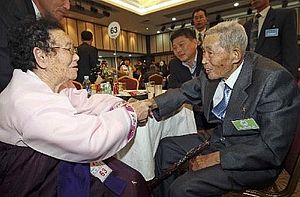February 20, 2014 was a day to remember for the two Koreas. It was the beginning of a five-day event at which members of war-divided families in both North and South Korea gathered at Mt. Geumgang to finally meet each other after decades of yearning. It was the first event of its kind since October 2010.
This historic event was a product of an involved process of inter-Korean politics. It began when North Korean leader Kim Jong-un spoke on the importance of improving inter-Korean relations in his New Year Address. Later, on January 16, the North Korean National Defense Commission sent an open letter via North Korea’s Korean Central Television calling for, among other things, an outright suspension of slander between the North and the South. The South Korean Ministry of Unification responded cautiously, noting that it was the North that broke the agreement and calling on Pyongyang to act first to show its “sincerity.”
Pyongyang did just that on January 24, when it proposed a reunion of war-torn families. Seoul replied to the proposal three days later, suggesting the event be held around February 17 to 22. After a period of silence, North Korea finally responded on February 3, asking for a Red Cross meeting on February 5 or 6 to discuss the reunion.
Further high-level meetings produced a rare North Korea concession, when it agreed that the reunion could go ahead during South Korea-US military exercise. Six days later, the reunion took place.
What are the strategic implications behind this North Korean responsiveness? Pyongyang has traditionally used the reunions as one of its strategic cards. As recently as September 2013, North Korea abruptly called off plans for a reunion, in a bid to gain the upper hand in the (ultimately failed) negotiations to reopen the tourist programs to Mt. Geumgang.
The reunions, held in the current form since 2000, have traditionally been conducted in exchange for South Korean humanitarian assistance. One official from South Korea’s Ministry of Unification has said that “during the era of Participatory Government (2003-2008, under late President Roh Moo-hyun), reunions were many times followed by provisions of food and fertilizers to North Korea.” The current government, under President Park Geun-Hye, seeks to take a similar approach, discussing follow-up measures related to the regularization of reunions and providing North Korea with food, pharmaceuticals, and fertilizers at the Standing Committee of National Security Council on February 15, and subsequently proposing to send preventive medicines to contain foot-and-mouth disease.
This coincides with Kim Jong-un’s efforts to overcome his country’s dire economic situation. Many experts argue that this year’s reunion was part of a North Korean bid to ease the challenges of its economic isolation. One official from the Ministry of Unification observed that “if Kim Jong-un pushed for internal restructuring in the first two years of his regime, addressing the economic situation will become a priority in his third year in order to stabilize the one-man regime. As such, attracting foreign investment is vital.”
North Korea has been struggling in the face of sanctions, including South Korea’s own and other sanctions imposed by the UN Security Council. The Rason Special Economic Zone, one of Kim’s major economic initiatives, is meanwhile in a perilous situation because of the reluctance of Chinese investors. North Korea needs to improve relations with the South and with the international community if it is to escape the sanctions. Pyongyang seems to be doing just that, given its recent meeting with Donald Gregg, former United States ambassador to South Korea, who visited the country in mid February.
In addition to the economic question, North Korea may also be seeking to get closer to the United States with hopes of engaging in a direct dialogue with the country. North Korean expert Chung Yong-Chul, a professor at Sogang University, has argued that “North Korea’s active approach to engaging with South Korea is part of a long-term process to approach the United States.” As evidence, he quoted the Chosun Shinbo, a North Korean media outlet based in Japan, which has made the same assertion.
North and South Korea have agreed to hold additional high-level meetings to discuss inter-Korean relations as well as further Red Cross meetings to explore ways of regularizing reunions. These will help determine how serious Pyongyang is about thawing relations with Seoul. Will economic desperation prompt North Korea to remain amicable throughout the Key Resolve military exercises, which continue until April 18, and beyond? This and many other questions remain, but the latest reunion does suggest that perhaps the third year of Kim Jong-un’s rule will be focused more on stability than on provocation, although there is no guarantee that Pyongyang will not resort to the latter.
Hyunmin Kang is a Ph.D. candidate at the Korea University Graduate School of International Studies. He is also editor at the National Human Rights Commission of Korea, where he worked with international and North Korean teams on issues associated with the UNCOI Reports on North Korean Human Rights.

































